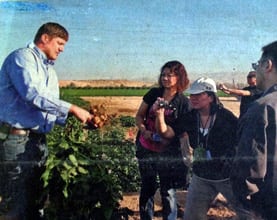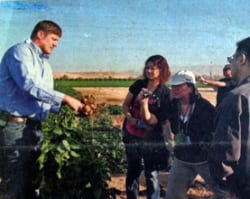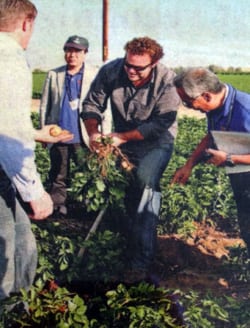
Asian Chip Makers Tour Tuber Territory
Potato Board hopes trade mission will increase exports
By: Cecilia Parsons — Capital Press
 A group of Asian snack manufacturers toured chip potato growing operations to see the main ingredient of their product on the vine. The U.S. Potato Board hopes the tour will ultimately lead to increased potato exports to Asia, a growing market. Rather than bringing their products to the customers the board invited the Asian snack manufacturing representatives to Oregon and California chip potato farms to see first-hand how potatoes are produced.
A group of Asian snack manufacturers toured chip potato growing operations to see the main ingredient of their product on the vine. The U.S. Potato Board hopes the tour will ultimately lead to increased potato exports to Asia, a growing market. Rather than bringing their products to the customers the board invited the Asian snack manufacturing representatives to Oregon and California chip potato farms to see first-hand how potatoes are produced.
Sarah Mahler, international marketing manager for the potato board, said the tour participants came from Japan, China, Thailand, the Philippines and Malaysia.
“There’s a marketing window we’re shooting for,” Mahler said. “They grow potatoes in those countries in fact China is one of the leading potato producers in the world, but they have to have a year-round supply and that’s what we’re looking at.”
Mahler said while other countries do produce potatoes, they might not have the varieties hat U.S. producers grow. They need potatoes that we low in sugar, easy to process and have disease resistance. They also need to buy potatoes when local supplies have dried up, she said.
One of the mare unique chip potato growers in Kern County is Brian Kirschenmann, the only chip potato exporter from the area. His main crop of chip potatoes is harvested in the spring, when 65-70 loads of potatoes will leave his shed every day. Kirschenmann also grows sells certified seed potatoes, some for export. For the last several years he has been experimenting with summer planted chip potatoes.
At his 75-acre field in the Lamont area, Kirschenmann reviewed the positives and the negatives of the three varieties he planted last summer, Mega Chip, Delta Pearl, and Marcy. They will be harvested in December and January. “We’re trying to get as big first set, hoping to get the growth before the weather turns cool. It’s a challenge.” Kirschenmann said. If the plants put out number instead of size, they won’t have a crop to harvest. They are not looking for a particularly big potato but a medium-sized, uniform harvest. Fall varieties typically produce about half the tonnage of a spring crop with yields in the 250-300 hundred-pound sack per acre range.
Besides trying different varieties of chip potatoes, he’s also working with different aged seed to see which will produce a better crop. One of the seed varieties he used couldn’t hold up in the summer temperatures. He’s also found planting the whole seed potato works best in the summer because there is less decay.
 Potato exporter Jason Davenport, who was assisting Kirschenmann with the tour, said chip potatoes need extra attention. “The harvesting, washing and storage are more technical, especially for those that will be exported.” Said Davenport who is with Allied Potato.
Potato exporter Jason Davenport, who was assisting Kirschenmann with the tour, said chip potatoes need extra attention. “The harvesting, washing and storage are more technical, especially for those that will be exported.” Said Davenport who is with Allied Potato.
Timing the harvest is critical, he said, because the potatoes have to have the proper sugar levels. Over-mature potatoes will yield a darker proceeded product, something manufacturers want to avoid. The mechanical harvesting and washing process has to minimize defects so there is less to trim off.
Once the potatoes are in storage, the sugar levels in the potatoes continue to be monitored. Shipping potatoes long distances is another challenge. Too cold and sugar levels rise. Too hot and decay sets in. Growers also don’t have control of storage conditions once the potatoes are in shipping container heading across the Pacific.
“They are the most difficult commodity to ship.” Said Kirschenmann, estimating that he exports only about 10 percent of his harvest. Davenport said that trade agreements with importing countries assist the process, but the potatoes still must pass phytosanitary requirements other countries have to keep posts and
Disease out of their crops. Chip potatoes are easier, he added, because the potatoes are processed.Mahler said that currently, Japan only allows imported potatoes from February to June. Chine does not allow potatoes to be imported, she said, but having their manufactures attend the tour allowed them see the advantages of U.S. potatoes.
